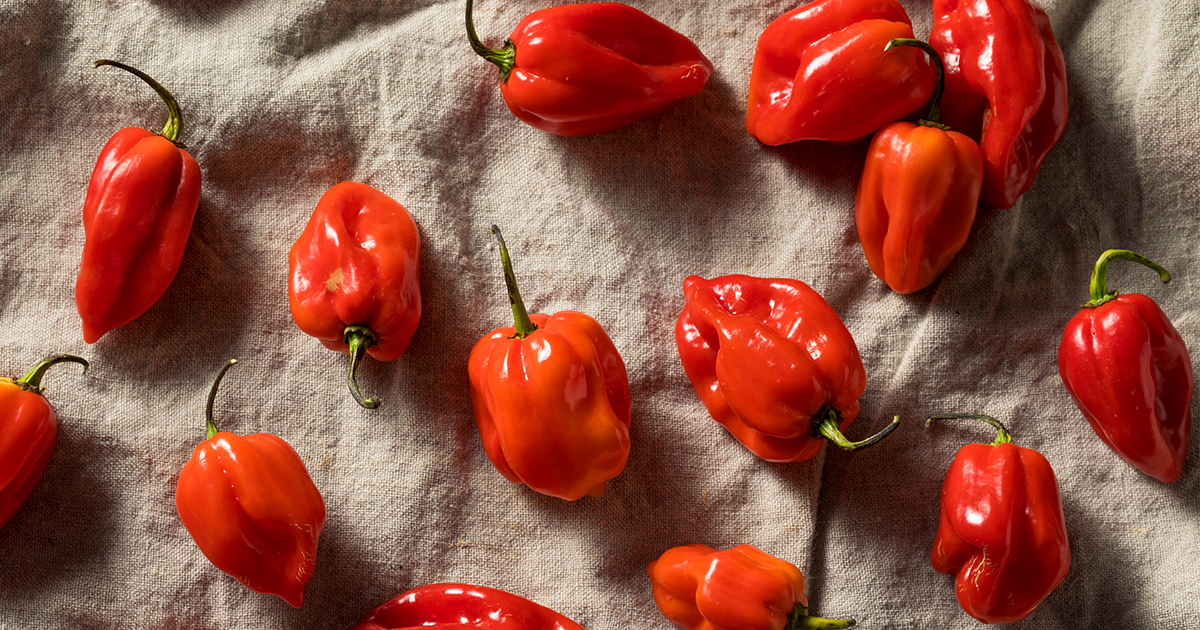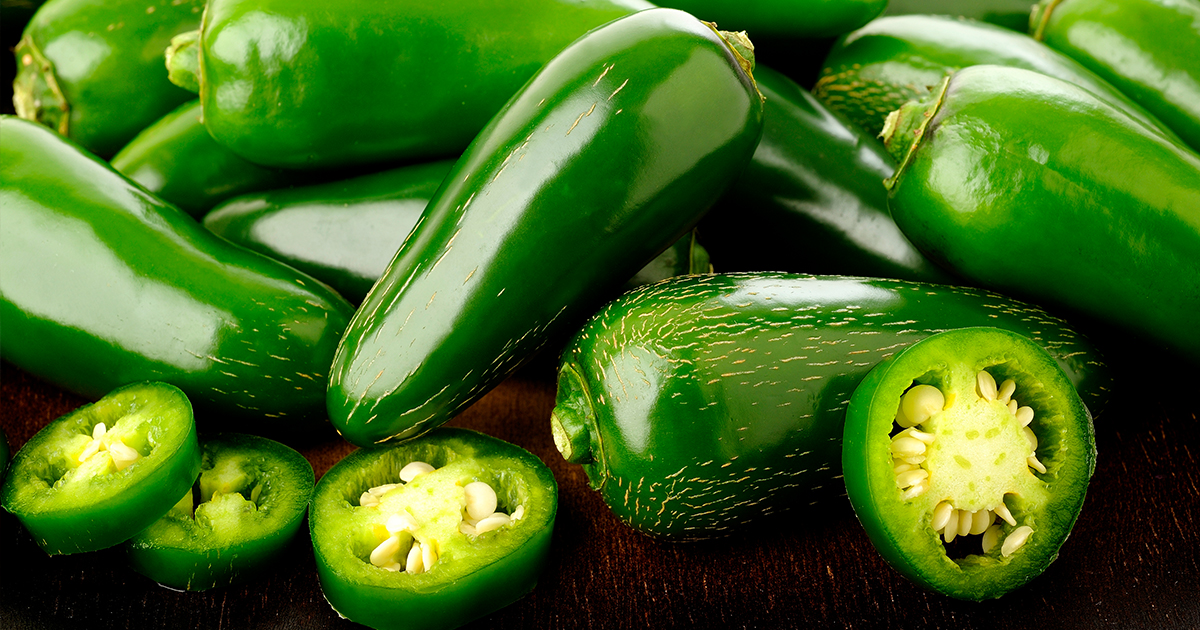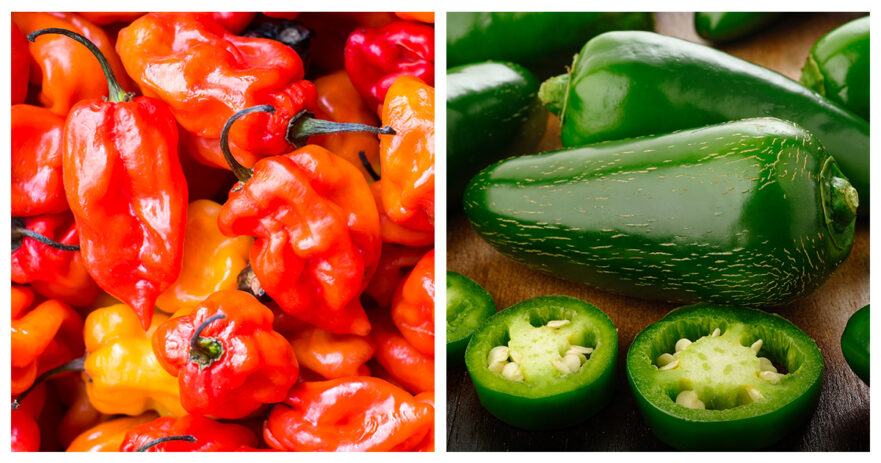Adding some spice to a recipe can completely transform the taste; that’s why it’s no surprise that peppers are a staple in loads of dishes worldwide.
If you’re someone that enjoys spicy food, you’ve most likely tried jalapeño and habanero peppers. And although they may look alike, there are definitely some distinct differences that set them apart.
So let’s dive into the unique features of these two fascinating and widely enjoyed pepper types!
| Habanero pepper | Jalapeño pepper | |
| SHU | 100,000 - 350,000 | 2,500 - 8,000 |
| Median SHU | 225,000 | 5,250 |
| Flavor | Fruity and floral, sweet with a significant heat | Grassy, vegetale, slightly sweet, and moderately spicy |
| Species | Capsicum chinense | Capsicum annuum |
| Origin | Peru, today biggest producer is Yucatan Peninsula, Mexico | Mexico |
| Uses | Salsas, hot sauces, jerk seasoning, marinades, etc. | Salsas, guacamole, nachos, jalapeño poppers, etc. |
Table of contents
What Are The Similarities Between Habanero And Jalapeño Peppers?
Habanero and jalapeño peppers may be different when it comes to heat and appearance, but they share several similarities.
For instance, they are both widely grown in Central and South America and belong to the genus Capsicum, with jalapeños falling under the Capsicum annuum species and habaneros falling under the Capsicum chinense species.
Whether it be in Mexican, Asian, or any other cuisine for that matter, both peppers are widely used and can often be found as a component of many different dishes.
For those who like a little bit of heat, jalapeños and habaneros are go-to choices for salsas, hot sauces, and marinades. They also work perfectly in soups, stews, and chili recipes or as tasty enhancements to tacos, enchiladas, or fajitas – add just the right amount of spice!
They can be eaten raw or cooked, stuffed, grilled, or roasted, depending on how you want them.
They thrive in warm climates and require minimal care when growing, making them an excellent choice for gardeners of all skill levels (as long you live somewhere warm).
With their rich history, cultural significance, and versatile uses, habanero and jalapeño peppers are truly loved by many. And that doesn’t look like it will change anytime soon.
What Are The Differences Between Habanero And Jalapeño Peppers?
One of the biggest contrasts between both types of peppers is their heat levels. Habaneros are significantly hotter than jalapeños, with a range of 100,000 to 350,000 on the Scoville scale! Unless you’re a fan of extreme spice, then they’re best avoided.
Also, their flavors are quite different. Habaneros are known for their sweet, fruity, and floral taste, while jalapeños have a milder, grassy flavor.
In terms of appearance, habaneros, and jalapeños can be clearly identified from one another. Habaneros are often smaller than jalapeños. They’re roughly 1-2 inches long and are shaped like small lanterns or bulbs. They have a waxy texture and come in various colors, including orange, red, white, and yellow.
Jalapeños, on the other hand, are longer and more slender. Typically, they’re 2-4 inches long and have smooth, shiny skin that is usually green but can turn red as it ripens.
FAQ about Habanero and Jalapeño peppers
What is the Scoville scale?
The Scoville scale is a way to measure how spicy peppers are. It was created by an American pharmacist Wilbur Scoville in 1912. The scale measures the amount of capsaicinoids in chili peppers, which is what makes them spicy.
At first, people used to determine the Scoville scale by tasting the peppers and rating how hot they were. But now, scientists use more accurate ways like high-performance liquid chromatography (HPLC) to measure the spiciness of peppers. This makes the Scoville scale more reliable than it used to be.
How could habanero peppers be used in the kitchen?
Habanero peppers are a versatile ingredient in the kitchen, commonly used in salsas, sauces, stews, and marinades. They can also be dried, crushed into a spice, or pickled.
How should habanero peppers be handled?
You should pick habanero peppers while wearing gloves due to their strong heat levels. Make sure to wash your hands with soap and water if you touch them with only your hands. They could irritate your skin and eyes too.
Are habaneros safe to consume?
Sure, eating habanero peppers is safe. Nonetheless, the intensity of their heat can result in burning feelings (mouth and eyes). Also, consuming them in high quantities runs the risk of causing respiratory discomfort. Because of this, it is advised to use habanero peppers sparingly, in moderation, and to handle them carefully.
What distinguishes jalapeno and habanero peppers from one another?
The habanero pepper has a distinctive fruity, sweet flavor with a floral scent. It is often smaller than the jalapeno pepper. Moreover, it has a Scoville heat range of 100,000 to 350,000, making it substantially hotter than a jalapeno. On the other hand, the jalapeno pepper has a milder, grassy taste and a Scoville heat rating ranging from 2,500 to 8,000.
What Is A Habanero?

The habanero pepper is unmistakable – its lantern-like shape and infamously high level of heat make it one of the most fascinating chili peppers out there. Its spiciness ranges from a blazing 100,000 to an intense 350,000 on the Scoville scale!
Evidence discovered during archaeological excavations demonstrates that habanero peppers have been grown in the Valley of Mexico for millennia, but current research indicates Peru may be their true origin.
Nowadays, the fiery habanero pepper is cultivated on tropical islands such as Cuba and the Dominican Republic.
The Yucatán Peninsula of Mexico is the largest producer of habanero peppers, using them to craft fiery and tasty sauces and salsas. In comparison to the jalapeño, the habanero pepper is more than ten times spicier – in other words, it’s one of the world’s hottest peppers!
The habanero is so hot in fact that it’s recommended that it should only be handled with gloves. Plus, if it accidentally touches your skin or eyes, the outcome can be extremely painful.
When it comes to using habanero peppers, they are versatile in many dishes, including salsas, sauces, stews, and marinades. However, that’s not all! The pepper adds heat and flavor to soups, vegetables, and meats. Furthermore, it can also be pickled, dried, or ground into a spice.
Finally, the habanero pepper has several great health benefits. It contains capsaicin, a compound that gives the pepper its fiery flavor, which has been shown to reduce inflammation, relieve pain, and much more.
What Is A Jalapeño?

Moving on to jalapeño, it’s a medium-sized chili pepper that originated in Mexico and is now regularly used worldwide. It is best known for its heat and distinctive bright green color that turns red as it ages. When it comes to the flavor of this tasty pepper, it can be described as grassy and slightly sweet.
Its heat level ranges between 2,500 to 8,000 on the Scoville scale, making it significantly milder than the habanero pepper.
The jalapeño is added to so many different types of recipes, including nachos, pizzas, and salads. In many cases, it is sliced and added to salsas, guacamole, and sauces.
What’s more, jalapeño peppers are sometimes pickled or canned and used as a topping or garnish. With their great versatility and mild heat, it makes sense that the peppers are an ideal ingredient for those who want to enjoy some spicy without breathing fire!
Just like the habanero, jalapeño peppers provide many health benefits. They are an excellent source of vitamin C, which can help boost the immune system, and they contain capsaicin, which we’ve already said possesses anti-inflammatory and pain-relieving properties.
